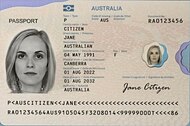
Back جواز سفر أسترالي Arabic Pasaporte australiano Spanish Austraalia pass Estonian گذرنامه استرالیایی Persian Passeport australien French Putovnica Australije Croatian Passaport australian LMO Passaporte australiano Portuguese Паспорт гражданина Австралии Russian Pasoš Australije Serbo-Croatian
| Australian passport | |
|---|---|
 | |
 The polycarbonate photo page of a current R series Australian passport | |
| Type | Passport |
| Issued by | |
| First issued |
|
| In circulation | 14.2 million (2023)[1] |
| Purpose | Identification & travel |
| Valid in | All countries |
| Eligibility | Australian citizenship |
| Expiration |
|
| Cost |
|
An Australian passport is a travel document issued by the Commonwealth of Australia to individuals holding any form of Australian nationality. An Australian passport application is the most expensive at AU$412 within the world since January 1, 2025.[3] It grants the bearer international passage in accordance with visa requirements and serves as both a form of identification and proof of Australian citizenship. It also facilitates access to consular assistance from Australian embassies around the world. Passports are issued in accordance with the Australian Passports Act 2005[4] by the Australian Passport Office, an agency of the Department of Foreign Affairs and Trade (DFAT). As of July 2024, Australian citizens had visa-free or visa on arrival access to 188 countries and territories, ranking the passport eighth in the world for travel freedom according to the Henley Passport Index.[5]
Since 24 October 2005, Australia has issued only biometric passports, called ePassports, which have an embedded microchip that contains the same personal information that is on the colour photo page of the passport, including a digitised photograph. As all previous passports have now expired, all Australian passports are now biometric. SmartGates have been installed in Australian airports to allow Australian ePassport holders and ePassport holders of several other countries to clear immigration controls more rapidly, and facial recognition technology has been installed at immigration gates.[6]
Since 1988 over a million Australian passports have been issued annually, and it reached 1.4 million in 2007, and increasing towards a projected 3 million annually by 2021.[7][8][9] As of late-2023, approximately 14.2 million Australian citizens (or just over 53% of the population) possessed a valid Australian passport.[10]
- ^ "Passport Facts 2022-23". Australian Passport Office. Retrieved 28 April 2024.
- ^ "Passport Fees". 1 July 2024. Retrieved 2 July 2024.
- ^ [1]
- ^ "Australian Passports Act 2005". austlii. Retrieved 11 December 2019.
- ^ "The Official Passport Index Ranking". Henley & Partners. Retrieved 5 July 2023.
- ^ "SmartGate Frequently Asked Questions – What is an Australian ePassport?". Australian Customs Service.
- ^ "Muehlbauer | www.muehlbauer.de" (PDF). www.muehlbauer.de. Archived from the original (PDF) on 20 December 2016. Retrieved 23 September 2020.
- ^ Whelan, Chloe (17 May 2023). "Australian passport is most expensive in the world to update". news.com.au. Retrieved 2 August 2023.
- ^ Wilson-Beevers, Helen (17 May 2023). "The world's most expensive passports revealed". The Independent. Retrieved 2 August 2023.
- ^ "Passport facts 2022-23". Australian Passport Office. 18 October 2023. Retrieved 25 February 2024.